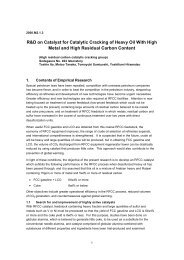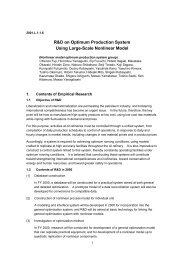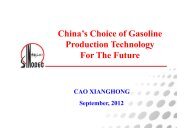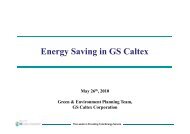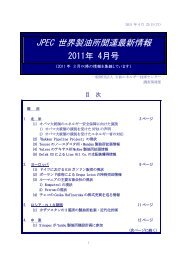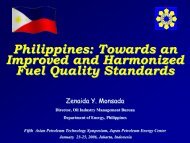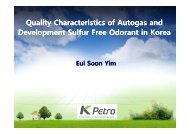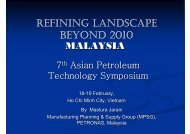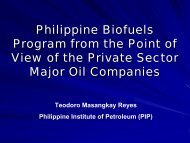R&D on Hydrogen Production by Autothermal Reforming
R&D on Hydrogen Production by Autothermal Reforming
R&D on Hydrogen Production by Autothermal Reforming
Create successful ePaper yourself
Turn your PDF publications into a flip-book with our unique Google optimized e-Paper software.
At the oil refinery, the hydrodesulfurizati<strong>on</strong> reactor operates with hydrogen partial pressure at<br />
2.0-3.0 MPa for light fracti<strong>on</strong> and at a high pressure of 10.0 MPa or greater for heavy fracti<strong>on</strong>.<br />
Nevertheless, with the small-scale fuel cell power generati<strong>on</strong> system, including power for<br />
household use, atmospheric pressure must be c<strong>on</strong>sidered in terms of the High-Pressure Gas<br />
C<strong>on</strong>trol Law, the Electric Utility Law, and so <strong>on</strong>. In the present research, therefore, the following<br />
two points were assumed for desulfurizati<strong>on</strong> reacti<strong>on</strong>.<br />
1. The raw material is kerosene <strong>on</strong> the market (with 50 massppm sulfur comp<strong>on</strong>ent).<br />
2. The reacti<strong>on</strong> pressure is atmospheric pressure.<br />
The purpose of the initial investigati<strong>on</strong>, therefore, was to determine desulfurizati<strong>on</strong> performance<br />
of active metals at atmospheric pressure. The c<strong>on</strong>stituents and c<strong>on</strong>figurati<strong>on</strong>s of catalysts used<br />
in evaluating activity are listed in Table 3.5.2. Desulfurizati<strong>on</strong> catalyst A is a regular<br />
extrusi<strong>on</strong>-mold-type hydrodesulfurizati<strong>on</strong> catalyst. Desulfurizati<strong>on</strong> catalyst B was prepared <strong>by</strong><br />
having precious metal, the active metal, retained in globular-shaped alumina, the carrier.<br />
Desulfurizati<strong>on</strong> catalyst C was obtained <strong>by</strong> molding base metal and zinc oxide in<br />
columnar-shaped tablets.<br />
A microreactor was used in evaluating the hydrodesulfurizati<strong>on</strong> activity of these three catalysts.<br />
Prior to the hydrodesulfurizati<strong>on</strong> reacti<strong>on</strong>, desulfurizati<strong>on</strong> catalyst A filled in the reactor<br />
underwent preliminary sulfurizati<strong>on</strong> for 2 hrs at 350°C via 5% hydrogen sulfide/hydrogen gas;<br />
desulfurizati<strong>on</strong> catalysts B and C underwent hydrogenati<strong>on</strong> pretreatment reducti<strong>on</strong> for 2 hrs at<br />
350°C under c<strong>on</strong>diti<strong>on</strong>s of hydrogen flow.<br />
3.5.2 Impact of Catalytically Active Metals<br />
Figure 3.5.1 presents the results of an evaluati<strong>on</strong> of the hydrodesulfurizati<strong>on</strong> activity of each<br />
catalyst in kerosene <strong>on</strong> the market with the H2/oil ratio at 100 and the reacti<strong>on</strong> temperature at<br />
250°C. The desulfurizati<strong>on</strong> activity of these three catalysts with LHSV = 10 can be expressed in<br />
relative terms from reacti<strong>on</strong> speed c<strong>on</strong>stant. When the activity of desulfurizati<strong>on</strong> catalyst A is<br />
taken as 100, that of desulfurizati<strong>on</strong> catalyst B becomes 250 and that of desulfurizati<strong>on</strong> catalyst<br />
C, 773, revealing that the activity of desulfurizati<strong>on</strong> catalyst C is the highest.<br />
Table 3.5.1: Properties of Raw Material Kerosene Used<br />
Distillati<strong>on</strong> (°C)<br />
IBP 152 Density g/cm 3 0.791<br />
10% 170 Compositi<strong>on</strong> Aroma % 22.4<br />
20% 177 Olefin % 0.2<br />
30% 185<br />
14<br />
Saturati<strong>on</strong> % 77.4<br />
40% 192 Sulfur comp<strong>on</strong>ent massppm 50<br />
50% 201<br />
60% 210<br />
70% 221<br />
80% 234<br />
90% 248<br />
EP 275




